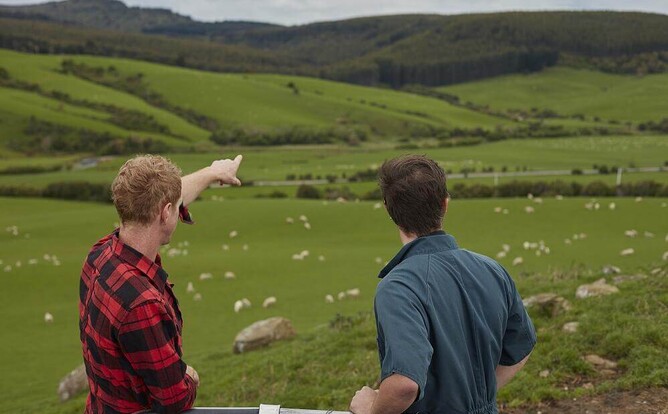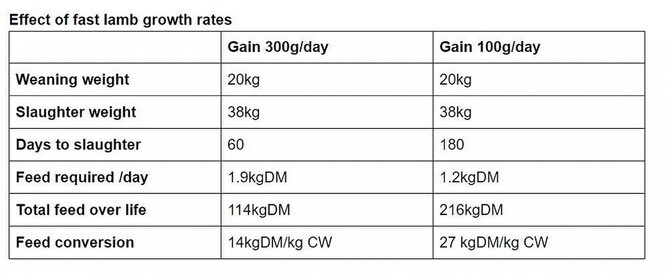Today the sun is shining and I feel like I can hear the grass growing, so hopefully, a few more days like this and your lambs will be thriving.
Lamb growth is influenced by feed, animal health, genetics, weather, and ewe condition/health. While the weather is out of your control, there are things you can do to manage lamb health. As we approach weaning, the risk factors for trace element deficiencies, some diseases, and stress increase.
Lambs that grow faster will reach slaughter weights sooner, and /or be heavier at the weaning draft (see table below). To get lambs growing at 300-400g/day they need:
- Plenty of good quality feed
- Good parasite control; using a fully effective combination drench appropriately, and quarantine drenching when buying in new stock is essential
- Liver vitamin B12 levels to be above 300nmol/kg
- Avoid wastage; vaccinate for clostridial diseases & reduce their pneumonia risk
Feed
Having enough good quality feed is the number one factor in finishing lambs well. Lamb growth is affected by ewe condition (ideally a 3+/5) and lactation, and ewe lactation is affected by feed. At peak lactation, ewes carrying one lamb require about 2.5kgDM/day and twinning ewes 3kg DM/day. Lambs start eating pasture from around 2-3 weeks of age, and it is vital that pasture quality is maintained throughout the summer months. In our pasture based farming system, lambs will grow most efficiently on ewe’s milk or lucerne/herb mixtures. Lambs weaned younger than 8 weeks grow slower than lambs on their mother.
Parasite Management
- As internal parasites are one of the most significant factors to contribute to poor lamb growth it’s important to have a plan in place. Worms suppress appetite and also damage the gut lining leading to poor absorption of nutrients. There is a number of ways in which we can control the worm burden in lambs:
- Drenching at 28 day intervals; the worm life cycle is approximately 21 days, so by allowing 7 days extra we can help create refugia. However, avoid stretching this out to 30-35 days, as that can make all the difference to your lambs having to deal with too high a worm burden.
- Refugia is still important! Have a chat with your vet as to how best to manage refugia on your farm, as it’s necessary to help reduce resistance to our drenches. This could include leaving some lambs undrenched, or grazing undrenched ewes with lambs.
- Don’t forget that alternate grazing with other species, such as cattle or deer, can reduce larval contamination.
- Check that your drench is still effective - you can do this by completing a full faecal egg count reduction test or by doing a drench check 10 days after drenching (with correct dosing). Have a chat with your vet to see what’s involved.
- Make sure you quarantine drench any new lambs coming on to your farm with a fully effective triple combination drench including a novel active.
Trace Elements
Selenium and B12 play a role in good lamb growth. One of the most economically important effects of selenium deficiency occurs in young stock up to 15months of age and manifests as slow growth and poor production. B12/cobalt can impact appetite and growth rates. A good way to get an idea of what your lamb’s selenium and B12/cobalt levels are is by taking some blood samples and liver biopsies on a few - we can do this under local anaesthetic and can help you to make informed decisions around supplementation.
If your lambs require a top up, you can give it in a number of ways. Mineralised drenches act very short term, raising levels for about 1 week, while short acting injections (e.g. Prolaject) last about 1 month, and long acting injections (such as Smartshot or Selovin LA), will provide about 4-6 months supplementation. You may also be putting cobalt &/or selenium in your fertiliser, in which case the duration will depend on the dosage and rate applied.
Disease
Nothing worse than the frustration of growing some good looking, plump lambs only to have them tip over suddenly, most likely due to a clostridial disease. While these diseases don’t cause ill-thrift, it’s an important step in getting your lambs away to slaughter without too many losses. As the lambs transition from milk and pasture to a solely pasture diet the gut flora will change and so the risk of Pulpy Kidney increases, especially in the fastest growing lambs.
Ensuring they are up to date with their clostridial (5in1) vaccine will reduce this risk. Some of these products also include selenium & B12 (e.g. Ultravac 5+1 +Se & B12) which can decrease the number of injections the lambs receive all at once. To reduce lamb wastage make sure vaccinations are up to date and reduce the risk factors that lead to pneumonia:
- 5in1/6in1 vaccine against the 5-6 main clostridial diseases affecting sheep in NZ. We would recommend you vaccinate them at or near weaning to cover them through summer until they go on the truck. Any lambs you keep will need a booster shot 4-6 weeks later.
- Pneumonia can also be a factor in ill thrifty lambs, with risk increasing by shearing lambs on the day of weaning (extra stressful), frequent yarding post-weaning (e.g. regular weighing), motorised mustering, and increased age of lambs at the slaughter. Preventative strategies include; watering the yards, scraping the dust off yards, reducing the use of dogs in yards, mustering in early morning/ evening, and bringing smaller groups into the yards at one time.
- Cecilia Landman


